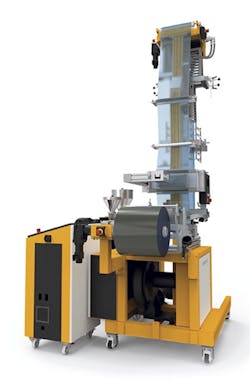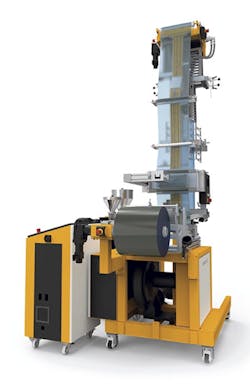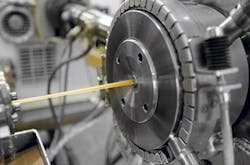Dr. Collin line improves bubble control
In October at Fakuma in Germany, Dr. Collin GmbH, Ebersberg, Germany, introduced a blown film line with new bubble-control technology, as well as a versatile die for making medical products such as multilayer film and tubing.
The blown film line, which is available in the U.S. through a subsidiary, Collin Lab & Pilot Solutions, is suited for processing a wide variety of resins. Thanks to its modular design, it can produce films with one to 13 layers up to 32 inches wide. Processors can easily switch dies and adjust the height of the blown film tower, the company said.
The line has a 7-inch touch-screen control and the company's new bubble-control technology, which precisely regulates airflow. This creates a very stable bubble circumference for a consistent final film width, even for very narrow blown film bubbles. The company's film inspection system, COFIS, uses a camera to monitor for defects.
Compared to previous Collin blown film lines, the new line is faster, with a standard speed of 164 feet per minute, up from 98 feet per minute. Higher speeds are possible, depending on the application, the company said. Collin also can adapt the line for specific resins or products, depending on customer requirements.
The line has a newly designed take-off unit and calibration basket, as well as a redesigned lay-flat unit. The take-off unit is designed so that it's easy to switchout the roll; a heated roll is optional.
The blown film line's newly designed winding module offers film-tension measurement and control, as well as a leveling roll for contact winding. The winder also can perform central winding and central gap winding.
The comprehensive optimization of the line results in very high-quality film rolls that are more easily converted into downstream products, Dr. Collin CEO Friedrich Kastner said in a news release.
At Fakuma, Collin used its new modular medical die in the new blown film line. The die can be used to extrude products with up to nine layers, and can be configured to make blown film, tubing or medical threads (also known as "strands") that contain an active ingredient, such as a medicine, that is released inside a patient's body.
The die also can be used to incorporate functional stripes into medical products. For example, the die can produce a catheter with a radiopaque stripe so that the catheter will be visible in X-rays. A stripe or stripes can be incorporated into any of the nine layers of the product, the company said.
There are other uses for the stripes. "People can use stripes for better identification. Different stripes can be used to clarify the physical characteristics or other specifications of different tubes or other products," said Barry Hunter, CEO of Collin Lab & Pilot Solutions.
Kathy S. Hayes, copy editor
Contact:
Collin Lab & Pilot Solutions Inc.Norcross, Ga., 678-325-6708, www.drcollin.de


